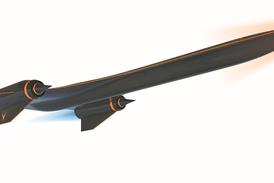Let no-one accuse Alain Bellemare and his team of any lack of foresight. Not only are they ready to pull the trigger on a torrent of very light jet engine production early next year, they are also talking to launch customers about how to shape their planned air-taxi operations.
 And when he’s not musing on the market of the century, the Pratt & Whitney Canada president is planning his company’s product line for five years from now.
And when he’s not musing on the market of the century, the Pratt & Whitney Canada president is planning his company’s product line for five years from now.“We’ve built capacity to produce over 2,000 PW600-family VLJ engines a year,” he says. “Our supply base is also ready for the ramp-up. Manufacturing the parts is one thing, assembling them another, but you’ve got to make sure you’ve got a flow of material throughout the supply chain.”
When PW600 production gets under way in the first quarter of next year - the PW615 for the Cessna Mustang is to be certificated towards the end of this year, the PW610 for the Eclipse 500 early next – engines are due to start pouring off the new line at Longueuil, near Montreal, at a rate of one per 8h shift.
At full output the line will turn out powerplants for at least three VLJ types: P&WC won a contract to supply the PW617 for Embraer’s VLJ this year and design work on that variant is under way.
Experience
“We’re drawing on the experience acquired on the PW610 and PW615,” says Bellemare. “But ultimately the design of all the PW600-family engines is driven by the need to drive down acquisition and operating.
“The central pillar of the P&WC cost-cutting strategy is simplicity. The PW600 series is a simple design, with a much reduced parts count compared with our other models. It’s also competitive in terms of weight and SFC [specific fuel consumption], and it’s rugged and maintainable, so that operating costs stay low throughout the life of the engine. We feel we’ve got a good balance of performance, SFC, weight and, most importantly, cost of acquisition and operation.”
Bellemare is convinced of the reality of the VLJ market, particularly the as-yet notional air-taxi segment. “I think there’s a need there. In the USA you’ve got 3,000 runways that are 3,000ft long and more, and a lot are under-utilized. The hub-and-spoke system is congested. So it’s clear that something is going to happen. I’m convinced that as soon as we have the tools – aircraft with low acquisition and operating costs – we will see potential operators emerging and trying different types of approach.”
P&WC is already talking to operators. “We’ve been working closely with DayJet, Pogo and others,” Bellemare reveals. “We’re in good shape when it comes to finding VLJ airframes to put our engines on, so we’re putting some effort into dealing with the launch operators who will play a critical part in making the air-taxi concept happen.”
P&WC is still pursuing new VLJ applications – “putting our engines on aircraft is our primary focus” – but it does see a need to influence the way the air-taxi concept is implemented. “It’s getting closer to reality, and we’ve got to be there with the operators,” explains Bellemare. “The interplay between engine, airframe and operator is critical.”
P&WC is also working to optimize the PW535E/airframe combination in preparation for launch of Embraer’s Light Jet next year. First ground run of this version of the PW535 is set for late next year. First flight is due at the beginning of 2007, with certification to follow by mid-2008.
Test
P&WC is shipping production PW307As to Dassault for the Falcon 7X, simultaneously amassing running hours on various test vehicles. Another member of the family, the PW308, is aboard the Falcon 2000EX.
Challenges or no challenges, Bellemare has found time to reflect on where the company needs to go over the next five years and beyond. “We have a great offer over the 1,000-8,000lb-thrust [4.5-35kN] range, so we’re examining a product for 8,000lb and above,” he says. “We’re also looking at revamping and re-energizing some of our older product lines, and we’re thinking about the helicopter business – we might go bigger there too.”
Source: Flight Daily News























